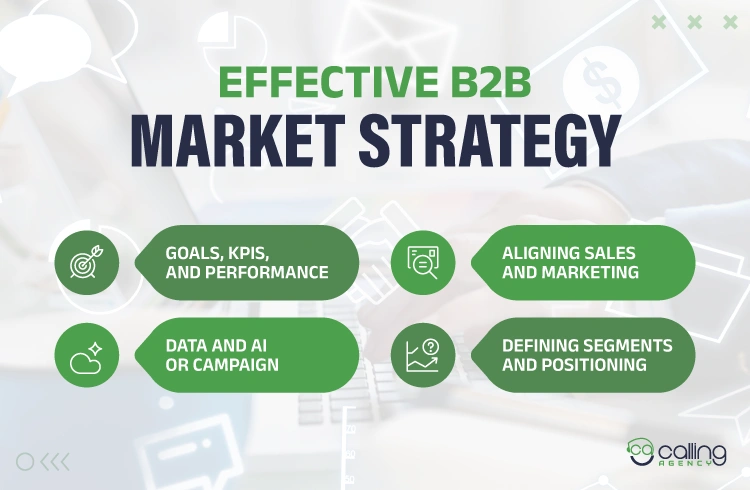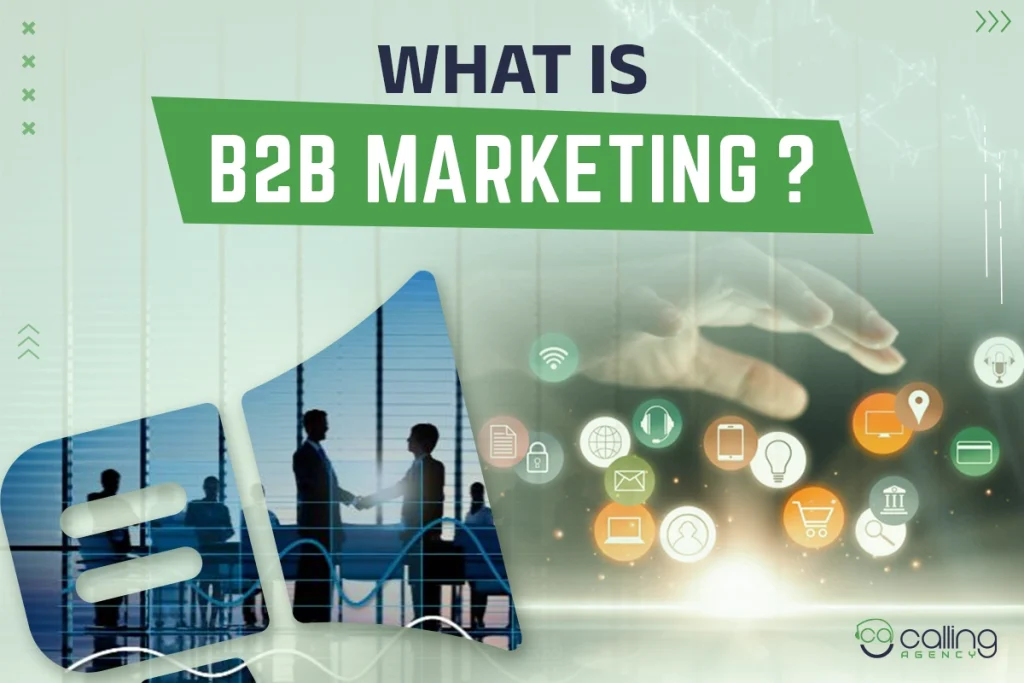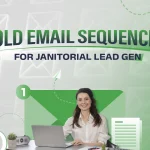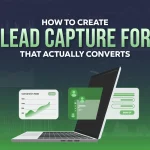Creating workable b2b marketing tactics can sometimes be challenging. Because it includes multiple processes and is filtered based on different criteria of the clients.
So, understanding the whole process of marketing for b2b business, we have come up with this complete blog for you.
In this article, our core discussion parts will be –
- Strategically mapping out the buyer’s journey in different stages.
- Properly setting up the goals, KPI, and performance metrics for marketing.
- Skillfully plan for the Account-Based Marketing(ABM) methods for each individual client.
- Choosing the right marketing channels to connect with potential customers.
- Structuring a B2B marketing funnel for getting the best result for the campaigns.
So let’s explore the entire blog to know more about the entire marketing process.
Understanding the Fundamentals of B2B Marketing
B2B (business-to-business) marketing is the sale of one business’s product or service to another business. Unlike B2C (business-to-consumer) marketing, B2B marketing is all about selling to decision-makers, typically company CEOs, purchasing managers, and department heads.
These are usually longer sales cycles, more consideration decision-making, and a higher-end purchase. This includes tactics such as email marketing, content marketing, LinkedIn outreach, trade shows, and account-based marketing (ABM). Things that make B2B marketing what it is.
Key Characteristics That Define B2B Marketing
- Target Audience: B2B marketers focus on specific businesses or titles, not broad demographics.
- Relationship-Focused: Trust and long-term relationships are more valuable than fast sales.
- Helpful Content: B2B buyers are looking for content that is informative, such as case studies, whitepapers, and demos, which helps them decide.
- Long Sales Cycle: B2B sales need approvals from other decision makers and have a prolonged sales cycle.
- ROI-Focused Messaging: The emphasis is on what the product or service can do to increase productivity or increase profits.
The Importance of B2B Marketing in Business Growth
B2B marketing is a critical tool in assisting businesses with attracting and retaining customers, producing quality leads, and generating long-term revenue. Even the most effective B2B solutions are vulnerable to uncertainty without proper marketing.
A well-executed B2B marketing strategy makes sure your value proposition is received by the right person at the right time. It’s a great way to build brand authority, build trust, and keep your pipeline full of sales-ready leads.
Comparing B2B and B2C Marketing Models
B2B and B2C marketing models are different based on the target customers, core objectives, purchasing cycle, and the communication process.
Both are focused on bringing people in and getting them to buy, but their audiences, sales processes, and marketing tactics are miles apart.
Having this understanding is also beneficial for B2B marketers, as it allows campaigns to be crafted with specific reference to the business buyer.
Variations in the Target Audiences and in Decision-Making
The B2B market addresses professionals and agencies. These are the buyers who care about logic, ROI, and long-term value, not emotion.
- B2B Buyers – CEOs, procurement offices, department heads, etc, who make decisions
- Purchasing Process – A Common buying journey that requires research, approval, and no significant amount of discussion
- Motivation – Value, efficiency, and business expansion
Then again, B2C marketing targets consumers who tend to act more quickly and emotionally.
Sales Cycles and Content Requirements Differences
The B2B sales cycle is long and complex. Buyers need the depth of information and multiple touchpoints before they make a decision.
Extended sales cycles with various stakeholders, etc.
Content types that perform well:
- Case studies
- Whitepapers
- Webinars
- Product demos
Core objectives are to educate, find trust, and validate ROI. And, on the flip side, B2C sales are increasingly faster, necessitating less depth of content.
Which Channels are Appropriate for B2B vs B2C?
To be better at B2B marketing, it’s critical to invest in platforms where professionals look for solutions and answers.
Effective B2B channels:
- Email marketing
- SEO and blog content
- Industry webinars and events
Focus points are thought leadership, lead nurturing, and building a relationship.
In B2C, marketers often rely on more visually heavy platforms like Instagram, Facebook, or TikTok environments where they can catch the eye and offer incentives for buying.
Mapping the B2B Buyer Journey Step by Step
Mapping out the buyer journey of b2b customers means constituting a complete path of potential customers regarding the buying process of products or services.
Which includes understanding the customers’ problems and pain points, and how your solutions will solve their problems. It might be any products that you are offering or any other services related to their problems.
| Identification of the problem → Explore the Solution → Creating Requirements → Ensure final Solution |
The Buyers Journey Stages(Point of View from Buyers)
Your potential buyers are looking for solutions to their problems in multiple stages. Let’s each stage properly.
- Awareness – In the awareness stage, the prospects are looking for solutions with reliable resources for their problems.
- Consideration – Now, the prospects identify the solutions related to their problems. They know what solutions are available.
- Decision Phases – This is the final stage of the purchasing or buying journey of the customer. The prospects are confident to purchase the product or service that will perfectly match their requirement and solve the issue.
Stakeholder Roles and Decision Dynamics for Buyer’s Journey
In the B2B purchasing journey, multiple roles and decision-makers are involved. To indicate these roles, it is necessary to map out the buyer’s journey. It will help you to grow your conversion rate.
- Core Decision Makers – Who takes the final purchase decision(CTO, CIOs, head of the departments, etc)
- Procurement Teams – Who negotiate contracts & manage vendor relationships for B2B purchases.
- Gatekeepers – Who allocate necessary information related to the buying process and provide it to the decision makers.
Building an Effective B2B Marketing Strategy
A consistent B2B marketing strategy needs to be well-planned, have laser-focused objectives and goals, and work alongside the sales team.
Opposed to the fast sales that are predominant in B2C, such is not the case in B2B marketing, which concentrates on establishing long-term relationships, nurturing leads, generating b2b leads, and solving real business problems.

Establishing Goals, KPIs, and Performance Metrics
Begin by defining what success means for your business. Your overall marketing strategy is guided by specific objectives and can be monitored to ensure that you are on track.
Common B2B goals include:
- Generating qualified leads
- Increasing brand awareness
- Boosting customer retention
- Improving conversion rates
After confirming what you hope to achieve, create some key performance indicators to help monitor your results. These metrics indicate what’s working and what might need some adjustment.
Useful B2B KPIs:
- Cost per lead (CPL)
- Lead-to-customer conversion rate
- Marketing qualified leads (MQLs)
- Return on marketing investment (ROMI)
How Data And AI Are Making B2B Campaigns Smarter
Data is the basis of contemporary B2B strategies. It’s helping marketers make sense of buyer behavior, segment audiences, and personalize content.
Use data to:
- Track engagement across channels
- Discover top-performing content
- Improve lead scoring and targeting
Artificial Intelligence (AI) goes a step further, whereby customers’ actions are where tasks are automated, and customer actions are predicted.
AI tools can help with:
- Lead scoring(Salesforce Einstein, Marketo Engage, Pipedrive)
- Email automation
- Chatbots for customer service
- Predictive analytics for campaign planning
Benefiting from data and AI lets you run smarter campaigns that adjust on the fly.
Aligning Sales and Marketing To Achieve Better Results
In a B2B context, sales and marketing have to collaborate closely. These teams not aligning can lead to lost leads and missed opportunities.
Ways to align both teams:
- Share buyer personas and lead data
- Use a shared CRM platform
- Hold regular strategy meetings
- Definition of MQLs vs. SQLs reached a cause
When sales and marketing are in sync, lead quality increases, and your business grows more quickly and more sustainably.
Designing a Winning Go-To-Market Strategy for B2B
A go-to-market (GTM) strategy is a detailed action plan of how you will take your product or service to market, launch it, and have your target buyers purchase it.
In B2B, this tactic needs to be extremely targeted, data-driven, and matched to your sales process. It’s not just about launching. It’s about launching with purpose and precision.
Defining Segments and Positioning Offers
In B2C, you can just put your company out there in the best way possible, and you’ll find your customers. To succeed in B2B, you need to know exactly who your ideal customers are. Begin by dividing your market into –
- Industry and company size
- Geography
- Business challenges
- Decision-maker roles
When you have segments, customize the way you present your offer to the pain points and specific needs of each segment of the group. Avoid one-size-fits-all messaging. B2B buyers are looking for solutions that address their business issues head-on.
Use ICP (Ideal Customer Profile) data to create targeted offers that demonstrate quantifiable business value.
Making Compelling Value Propositions
Your value proposition should explain how your product resolves a specific issue and why it’s better than any other option. For B2B, concentrate on end results like –
- Saving time or costs
- Improving workflow or compliance
- Boosting productivity or revenue
A B2B value proposition might include:
- Who it for
- What it does
- How it helps
- Why it different
Make it short and informative, and keep the business value central.
Using Sales with the Proper Tools
Your GTM(go-to-market) strategy must back up your sales team. They require the tools and resources to connect with prospects and to execute and close deals with confidence.
Sales enablement tools to provide:
- Product brochures and demos
- Case studies and use cases
- Email templates and scripts
- CRM access and lead intelligence
The more that sales teams know about your audience and have the right materials, the better they can personalize outreach and move leads through the funnel sooner.
Reaching High-Value Accounts with Account-Based Marketing
Account-Based Marketing (ABM) is a B2B approach where businesses target a smaller number of high-value accounts with individual campaigns. Rather than focusing on a broad audience, however, ABM unites sales and marketing to approach all target accounts as a market of one.
What ABM Is & Why It’s Effective for B2B
ABM is a very targeted strategy, in which you customize your marketing to appeal to specific companies, usually large ones or prospects that are the perfect fit for your brand.
Why ABM is effective in B2B:
- It is a complicated decision process, and there are a number of players.
- Trust and personalization are essential in long sales cycles.
- It brings marketing and sales in tune with each other.
- Specialization equals more ROI and deal value.
Steps to a scalable ABM process
- Identify high-value accounts.
- Use firmographic data, customer lifetime value, and sales feedback to determine which accounts have the most potential.
- Build account-specific personas.
- Know the personas of decision influencers at an account.
- Personalize content and outreach.
- Develop custom emails, ads, landing pages, and content assets focused around unique business needs.
Use the correct tools and platforms.
- ABM platforms such as Terminus, Demandbase, or HubSpot streamline and automate scaled campaigns.
- Measure and optimize the results.
Monitor metrics such as engagement, pipeline growth, and closed deals by account to iterate your strategy.
Differentiating ABM from Account-Based Selling
Although ABM is a marketing-led strategy that identifies and targets entire accounts, Account-Based Selling (ABS) is essentially the sales arm of the same area.
- ABM is all about generating awareness and engagement at the account level.
- ABS teaches you to establish a relationship, overcome objections, and get the deal done.
- When ABM and ABS converge, you have a single methodology for winning and growing high-value B2B clients.
Developing Detailed B2B Buyer Personas That Convert
To ensure the effectiveness of the overall b2b marketing process, you must analyze the proper buyer personas.
Determining the buyer personas means identifying the target customer or potential clients for your business. Here, one thing is important: they might have a significant interest in taking your service or product from you.
Key Attributes to Include in B2B Personas
For researching the buyers’ persona, you have to focus on these factors. Basically, these are the key attributes in terms of properly identifying the buyers’ personas.
- What are the demographics of the potential customers(industry type, company size, location, employee amount, etc)
- What are their core objectives, and what problems are they facing?
- What is their decision-making process while they are purchasing any product or service from you?
- What are their preferred channels for the communication process(emails, social media, and any other methods)
- What are the buyers’ information-seeking sources?
- What is the buying behavior of the b2b clients? (clients’ buying criteria, purchasing budget, and timeline, also the decision-making process before buying)
Applying Personas Across Campaigns and Channels
You have got reliable data about the buyer personas of the clients. Now it’s time to implement them for creating marketing campaigns on relevant channels.
- In terms of content marketing, you can easily create content (blogs, white papers, case studies) focusing on the client’s pain points and goals.
- Try different types of content formats that might be infographics, video content, webinars, etc.
- For the channel selection for the b2b marketing campaign, LinkedIn is the best option. You can run the campaigns on LinkedIn by targeting potential clients.
Structuring the B2B Marketing Funnel for Maximum ROI
A good B2B marketing funnel is designed to attract, engage, and convert leads into customers while getting the most out of your investment. For it to work, each funnel stage needs to use specific tactics that reflect where the buyer currently is in their journey.
Top, Middle, and Bottom Funnel Engagement Strategies
This is the commonly used and result-driven marketing funnel for b2b marketing strategies.
Top of Funnel (TOFU) –
- This phase is all about recognition. You need to capture the excitement and inform the leads.
- Use SEO-optimized blog posts, LinkedIn content, and webinars.
- Share industry knowledge, how-to guides, and infographics.
- Concentrate on addressing common business needs.
Middle of Funnel (MOFU) –
- Now that your leads know, it’s time to build trust and prove your authority.
- Provide case studies, whitepapers, and email nurture sequences.
- Launch product comparison guides and targeted ads.
- Host ‘demo’ webinars, or expert interviews.
Bottom of Funnel (BOFU) –
- This is the decision phase where help leads end up choosing you.
- Share free trials, demos, and customer success stories.
- Offer exchange-specific ROI calculators and proposal forms.
- Sale and marketing agreement must be made on Messaging.
Lead Nurturing Techniques to Reduce Sales Cycles
B2B buyers do not make decisions as quickly, but you can speed up the issue in one way or another.
Using email workflows for automated, relevant content. Through email workflows, we deliver timely, relevant content. Retargeting ads to remind people of your brand.
A certain extent of scoring leads and sending only to sales-ready ones fast.
Metrics that reveal funnel effectiveness. Here’s what you should track to measure your funnel’s effectiveness:
- Lead conversion rate through every stage
- Customer acquisition cost (CAC)
- Marketing qualified leads (MQLs) v sales qualified leads (SQLs)
- Funnel velocity (how quickly leads are progressing through the stages)
Choosing the Right Marketing Channels for B2B Growth
Using the right marketing channels is necessary for marketing for b2b businesses. Otherwise, the marketing efforts will go in vain. You will not get the right results from your campaigns and grow your conversion rate.
Using Email Marketing Channel for B2B Businesses
The email marketing process is one of the effective ways of reaching out to the target customers or clients for your business.
Here are some important factors for creating a proper email marketing strategy to get the best results.
- For running your campaign, first you have to focus on the segmentation. Customize the emails targeting specific roles, industries, and business purposes, and requirements.
- Structure the emails based on the customers’ buying stages, such as awareness, consideration, decision making, retention, and advocacy.
- Use the right email template based on purposes(thank you emails, welcome emails, round-up emails, newsletter, etc)
Using LinkedIn for B2B Awareness
Another powerful option is using the LinkedIn platform for your b2b marketing process. Specifically, LinkedIn is the best channel for creating awareness and connecting with clients.
- With the help of LinkedIn Sales Navigator, you can easily find out the potential clients for your b2b business.
- Also, LinkedIn outreach manager helps to reach the targeted b2b clients more effectively.
- By creating multiple types of posts related to products and services, a positive effect on raising awareness among potential customers.
Exploring Current Trends and Innovations in B2B Marketing
The world of B2B marketing processes is constantly changing. Different types of tools and technologies are coming & the strategy of marketing is constantly changing.
The Role of AI and Automation in Modern Campaigns
In the current situation, AI and automation have become an integral part of the modern b2b marketing campaign process.
- For marketing data analysis, such as competitor research, lead data research, and buyer persona analysis, AI tools help a lot. Some of the common tools are Quantilope, Zappi, Brandwatch, etc.
- AI specifically helps in current trend analysis, marketing data visualization, sentiment analysis, competitive intelligence, etc.
- Automation helps in a proper b2b lead generation, lead qualification, and prioritization system.
- Multiple types of marketing automation tools are available that have focused features for automating the email marketing campaign. So that you can easily segment different types of email campaigns for different events on various schedules.
- Chatbot and most of the communication tools are available with AI integration features. So you can easily manage your customers’ communication related to their problems with these tools.
Final Words
So, are b2b marketing methods easy? Well, the answer is easier if you can use the exact method by targeting exact customers, your campaign will work. We have gone through a complete discussion about the b2b marketing process.
From this discussion, you will gather wholesome knowledge about it. Then you can easily implement them on your marketing strategies to get the best result.





